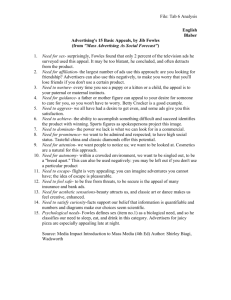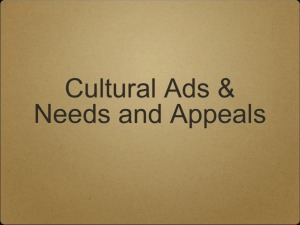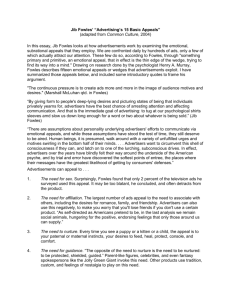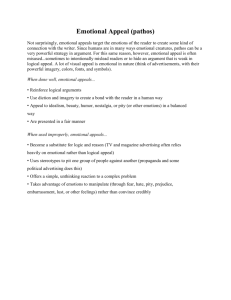File
advertisement
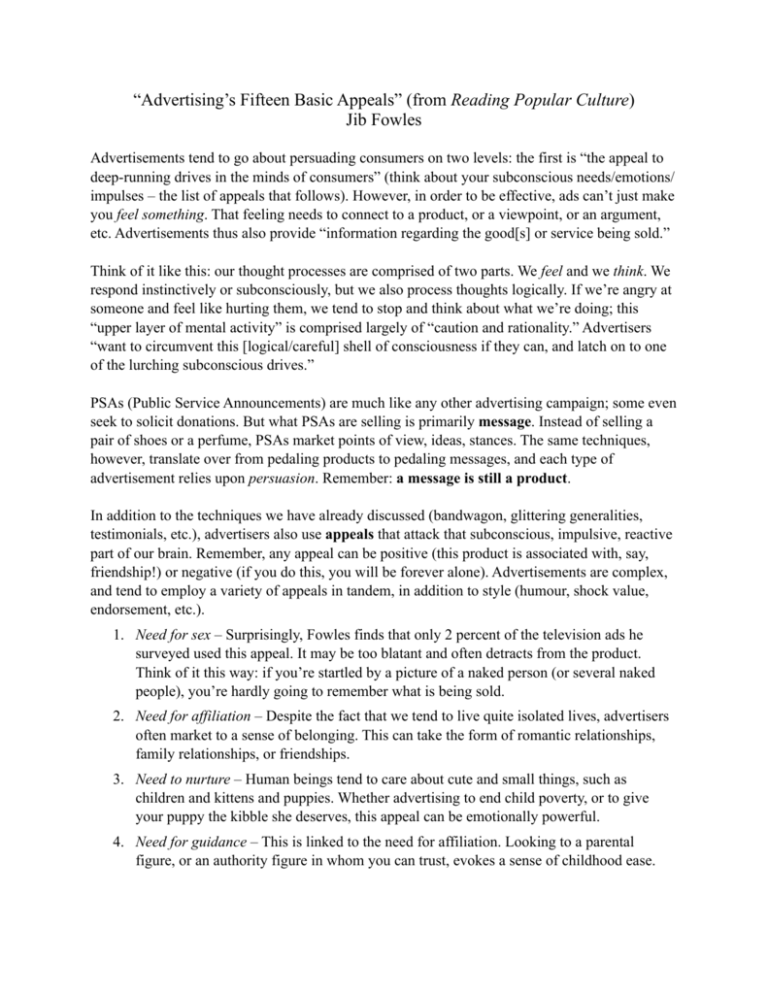
“Advertising’s Fifteen Basic Appeals” (from Reading Popular Culture) Jib Fowles Advertisements tend to go about persuading consumers on two levels: the first is “the appeal to deep-running drives in the minds of consumers” (think about your subconscious needs/emotions/ impulses – the list of appeals that follows). However, in order to be effective, ads can’t just make you feel something. That feeling needs to connect to a product, or a viewpoint, or an argument, etc. Advertisements thus also provide “information regarding the good[s] or service being sold.” Think of it like this: our thought processes are comprised of two parts. We feel and we think. We respond instinctively or subconsciously, but we also process thoughts logically. If we’re angry at someone and feel like hurting them, we tend to stop and think about what we’re doing; this “upper layer of mental activity” is comprised largely of “caution and rationality.” Advertisers “want to circumvent this [logical/careful] shell of consciousness if they can, and latch on to one of the lurching subconscious drives.” PSAs (Public Service Announcements) are much like any other advertising campaign; some even seek to solicit donations. But what PSAs are selling is primarily message. Instead of selling a pair of shoes or a perfume, PSAs market points of view, ideas, stances. The same techniques, however, translate over from pedaling products to pedaling messages, and each type of advertisement relies upon persuasion. Remember: a message is still a product. In addition to the techniques we have already discussed (bandwagon, glittering generalities, testimonials, etc.), advertisers also use appeals that attack that subconscious, impulsive, reactive part of our brain. Remember, any appeal can be positive (this product is associated with, say, friendship!) or negative (if you do this, you will be forever alone). Advertisements are complex, and tend to employ a variety of appeals in tandem, in addition to style (humour, shock value, endorsement, etc.). 1. Need for sex – Surprisingly, Fowles finds that only 2 percent of the television ads he surveyed used this appeal. It may be too blatant and often detracts from the product. Think of it this way: if you’re startled by a picture of a naked person (or several naked people), you’re hardly going to remember what is being sold. 2. Need for affiliation – Despite the fact that we tend to live quite isolated lives, advertisers often market to a sense of belonging. This can take the form of romantic relationships, family relationships, or friendships. 3. Need to nurture – Human beings tend to care about cute and small things, such as children and kittens and puppies. Whether advertising to end child poverty, or to give your puppy the kibble she deserves, this appeal can be emotionally powerful. 4. Need for guidance – This is linked to the need for affiliation. Looking to a parental figure, or an authority figure in whom you can trust, evokes a sense of childhood ease. While some advertisements appeal to the need to nurture, this appeal is grounded in the need to be nurtured. 5. Need to aggress – Many of us have had a desire to get even, and some advertisers play on this. Even associating violence or rebellion with a product can tap into this need (“There’s a tiger in your tank” – appeals to feelings of aggressive assertion). 6. Need to achieve – This is a need that motivates many people throughout their lives and careers. It tends to rely on an association between a product and victory, or winning, or success. 7. Need to dominate – This is linked to the need to achieve and the need to aggress, and is in tension with the need for affiliation. This appeal relies on the need to feel powerful and in control. Although often coded as masculine, it can be tapped into for any gender. 8. Need for prominence – We want to be admired and respected, to have high social status. This need often taps into class tensions/structures and reinforces the idea that our society is “not so egalitarian after all.” 9. Need for attention – The need for attention is grounded in “the need to be looked at. The desire to exhibit ourselves in such a way as to make others look at us is a primitive, insuppressible instinct.” This is a technique used primarily to market to women, but applies to all genders. 10. Need for autonomy – Unlike the need for guidance, the need for autonomy reminds the consumer that he or she wants to do things his or her own way. It is “the need to endorse the self” – to highlight the “independence and integrity of the individual.” 11. Need to escape – This appeal hits up the pervasive desire to leave it all behind, to “duck out of our social obligations, to seek rest or adventure.” It tends to focus on the individual, although escape for multiple people – forgetting about that meeting over a cup of Van Houtte at a cabin with one’s partner – is a possibility as well. 12. Need to feel safe – Humans are hard-wired for self-preservation, and working in ways to prevent future harm is a primordial impulse. Think of ads for life insurance, or ads for cars that have been rated as extremely safe. 13. Need for aesthetic sensations – Ads that are ugly will not do well. Humans are visual creatures, and lay-out, colour, image, text placement, font choices, music choices all factor in to how we respond to advertisements. 14. Need to satisfy curiosity – Facts support our belief that information is quantifiable, and by using numbers, graphs, and data, advertisers tap into our innate appreciation for knowledge. 15. Physiological needs – Appeals to our need to sleep, eat, drink (and, arguably, have sex) all fit here. Food advertisements that glorify food with extreme close-ups are excellent examples of this type of ad. (Summary adapted from Ventura English) Aristotle’s Appeals Aristotle claimed that appeals fall under three branches: 1) Logos – appealing to a sense of logic, rationality; this logic does not always need to be sound, but it appears persuasive because of its apparent rationality 2) Pathos – Appealing to the audience’s passions/emotions 3) Ethos – Relies on the credibility of the persuader. To be credible, the persuader must have good morals, good sense, and good will. It is the root of the word ethics. Modern Day Appeals (Shcenck-Hamlin) Appeals are based on: 1. Sanctions - Motivation through rewards punishment 2. Needs - Appeals to human motivations and values (i.e. belonging, self-esteem, self awareness, etc.) 3. Rationales - Uses supporting evidence. Types of Appeals Sanctions Fear Promise Ingratiation Debt Allurement Aversive stimulation Warning Needs Belonging Security Esteem (positive) Esteem (negative) Rationales Direct request Explanation Hinting Examples If you don’t do this, horrible things will happen. If you do this, I will do something for you/give you something. I have already done nice things so you will honour my request. You owe me for past favours. Other people will reward you for this behaviour. I will continue to punish you until you concede. Other people/events will cause you unhappiness if you don’t comply Other people will like you if you comply. You will be safe if you comply. Your self-worth will increase if you comply. Your self-worth will decrease if you don’t comply. Others will think less of you. Please do this. This is the logical thing to do. (Evidence provided) I’m not going to tell you what to do. I’m going to give you hints until you do this of your own accord.



